Whenever I read about someone enjoying their porridge plain, ‘with just water and salt’, a small part of me withers and dies quietly inside. It is often, apparently, meant to seem like a badge of honour (specifically, a sort of Spartan-cum-Northern honour): look how I shun the decadent trappings of modern culinary life in favour of my abstemious bowlful of gruel; look how little I require to achieve true happiness. While I am undoubtedly envious – imagine how much simpler one’s entire existence must be if one is sated by just oats and salt – I can’t help but think of all the opportunities that are closed down by that Puritan preference for a no-nonsense breakfast bowl.
Read moreMy ultimate hot cross buns
When I first made hot cross buns as a teenager, they ended up more like hot cross rock cakes. I think maybe I over-proved them, or left too much space between each bun on the baking tray, so they puddled out like strange, beige, fruit-speckled UFOs. They were delicious, but I found myself rather disheartened at their complete lack of resemblance to those perky, burnished, perfectly-crossed specimens you can buy in the supermarket. Every year since then – and, sad to say (or a relief?), many have elapsed between my teenage years and the present – I’ve been trying to create a hot cross bun that rivals those upmarket bought varieties.
Read moreApple, cinnamon and sultana hazelnut crumble cake
Baking, in our culture, is so often inextricably connected with love. Family memories and relations are shaped around food; some of our fondest recollections of our mothers and grandmothers are perfumed by the heady scent of a baking pie or cake. Missing the closeness of home and the familiarity of domesticity is frequently couched in terms of our longing for a particular dish, and even parental ineptitude in the kitchen is usually recalled with wry affection. Childhood friendships are formed and dissolved over the sharing of cake and other baked goods: I still remember once refusing to speak to my best friend for a week because she stole my lunchtime flapjack and ate it. We bake cakes, bread, brownies to cheer up our loved ones or as a token of our affection; the humble combination of flour, butter and sugar has become fetishized in our culture to such an extent that we apparently believe there are few gifts more redolent of love than a homemade baked good.
Read moreRhubarb and ginger brack
I used to make myself a tea loaf every few days when I was in my second and third year of university. I remember this very distinctly. I can remember the exact spot on my bookshelves in my room where I would keep the polka-dot Emma Bridgewater cake tin (a present - I can never afford that sort of stuff normally). I can remember my daily afternoon ritual: returning from the Bodleian to have lunch, then working in my room for the rest of the day, occasionally getting distracted by people-watching through my gigantic bay window that looked out onto a busy thoroughfare (sometimes I'd see a friend frantically waving up at me). Around four o'clock, I'd make myself a big mug of tea, slice a thick slab of tea loaf, lick the sugary residue off my fingers after transporting it to a plate, and sit down, settled, a fork in hand.
There I would sit, sun streaming in through the window, books piled up around my laptop, tea steaming, the faint sound of voices and laughter emanating from the street outside. Mouthful after sugary mouthful, the tea loaf would disappear in a haze of sweet stickiness, and I would feel revived, ready to carry on with Marvell or Richardson or Defoe or whatever else I had to set my mind to that afternoon.
Sometimes it was banana bread, when I had bananas to use up, but often I'd make various variations on the theme of a tea loaf. Tea loaves are, to me, a quintessentially British bit of baking. They involve steeping dried fruit in strong tea for several hours (or overnight), before mixing this fruit and tea medley with flour and eggs; sometimes a little sugar (not much is needed as the fruit is so sweet), sometimes ground almonds to add moisture; sometimes a pinch of warming spice. The main point is that there is no fat added: the tea-soaked fruit makes the cake perfectly moist and gooey without the need for butter or oil. Thus, the beauty of the tea loaf: good for those watching their waistline.
I wasn't, incidentally, but few things can perk up the academic brain more than a slice of cake packed with dried fruit. I used to use apricots, figs, prunes, dates and sultanas. My favourite mouthfuls were those featuring the dates, which turned gloriously sticky and toffee-like during the baking process. Sometimes I added almonds, for a little crunch, or steeped the fruit in orange juice instead of tea.
I love the magic that happens when you soak dried fruit. Used to eating it raw, or throwing it raw into things like cakes and breads, I forget how deliciously plump and juicy it becomes after a nice hot bath. The saturated fruit makes the cake all the more moist, sticky and gooey. It's kind of how a fruit cake should be - I always find those fruit cakes we make on festive occasions, like Christmas cake or simnel cake, far too dry.
There's something intensely comforting about a tea loaf. It's solid and robust, a good, proper, old-fashioned cake. It often has a lovely crunchy crust around the outside, while the inside is gloriously moist and gooey from all the fruit. The fruit is plump and sweet, having absorbed the tea or juice, while the cake itself is fluffy, often with a hint of spice. It's the kind of thing you eat when you are feeling a bit sad, or a bit tired, or a bit peckish. I can't think of something better to revive you in the afternoon. Also, because it's lower on sugar than most cakes, it doesn't give you a horrible sugar crash when you come back down to earth - the dried fruit is good, honest, slow-release energy. At least I feel it is; I'm no nutritionist.
You can eat a tea loaf spread with a little butter, but when it's fresh from the oven it needs no accompaniment other than tea. The smell as it bakes, filling your kitchen with homely, warming aromas, is - for me - what baking is all about.
This recipe is inspired by my recent trip to the Wakefield Rhubarb Festival. There I bought a delicious rhubarb and ginger 'brack', an Irish name for a sweet, fruited bread that is now often used to denote a tea loaf. I gave it to my mum for Mother's Day, and it only recently emerged from the freezer, allowing me to finally have a taste. It's delicious - quite a dense cake, with wonderfully gingery, sweet sultanas and sticky chunks of rhubarb. The sort of thing you could almost justify having for breakfast. It feels wholesome, somehow, robust and earthy and inviting.
Inspired by a few mouthfuls of this, I decided to have a go at creating my own. Having never made a rhubarb tea loaf before, I experimented, basing my recipe on a few others I'd come across online and the taste and texture of the brack I had bought. I was a little worried it wouldn't work, but it did - beautifully.
I soaked a mixture of raisins, finely chopped crystallized ginger and finely chopped rhubarb in strong Earl Grey tea overnight (part of me wanted to use Yorkshire tea, given the provenance of rhubarb and where I live, but I thought Earl Grey would add a lovely floral fragrance). In the morning, the raisins were plump and the ginger had perfumed the whole thing with its sharp, hot scent. To this mixture I added an egg and a little brown sugar, then folded the whole lot into flour, baking powder, ground almonds, a hefty amount of ground ginger and a little cinnamon. I wanted the whole thing to be really gingery - I almost considered adding some stem ginger syrup as well, but restrained myself. The batter was the perfect consistency (I worried I'd put in too much tea, and the rhubarb would be watery) as I spooned it all into a lined loaf tin.
This honestly is one of the easiest cakes you could ever make. I whipped it up in the time it took me to make a cup of tea to go with my breakfast. You only need a couple of bowls and spoons, and a loaf tin. And an oven, of course. I really love how simple and homely it is - just a few ingredients, no fancy techniques (not even a whisk needed), and the result is a beautiful old-fashioned loaf.
And the taste? Fantastic. It's incredibly gingery, fiery bursts of crystallised ginger peppering the dense, moist crumb. This, though, is tempered by the gooey pieces of rhubarb throughout, and the sweet, plump raisins. I actually think it's better than the brack I bought from the festival! Although tea loaves have a tendency to be quite dense, the juicy rhubarb in this really lightens it, while still making it seem indulgent. You could serve it as a pudding after a light meal, with some ice cream, or have it for breakfast spread with butter. I ate it still warm from the oven, unable to believe that my spontaneous experiment had worked out quite so well.
If you're a rhubarb fan, or a ginger fan, I'd urge you to try this. It's unlike any other rhubarb or ginger cake I've tasted, and perfect for lovers of very gingery cakes. For such a simple recipe, it's immensely rewarding. And, even better, it's low-fat - but you wouldn't guess.
Rhubarb and ginger brack (makes 1 loaf):
- 300ml strong, hot tea (I used Earl Grey)
- 100g raisins or sultanas
- 150g finely diced rhubarb
- 50g crystallised ginger, finely chopped
- 200g plain, wholemeal or spelt flour
- 50g ground almonds
- 2 tsp baking powder
- 1 1/2 tsp ground ginger
- 1/2 tsp ground cinnamon
- 1 egg
- 75g light brown sugar
- 2 tbsp demerara sugar, for sprinkling (optional)
Soak the raisins, rhubarb and crystallised ginger in the tea overnight.
When ready to bake, pre-heat the oven to 170C. Grease and line a loaf tin with baking parchment. In a large bowl, mix together the flour, almonds, baking powder, ginger and cinnamon. To the tea and fruit mixture, add the egg and sugar and stir together. Pour the fruit mixture into the flour mixture, and mix with a large spoon or spatula until evenly combined.
Pour the mixture into the loaf tin, then sprinkle with the demerara sugar, if using. Bake for 55 minutes, until the top of the loaf is crusty and golden, but still gives slightly in the middle when pressed. Leave to cool a little before slicing and serving. It's also very good the next day spread with butter, and freezes well.
Orange and pistachio stollen squares
Christmas in the kitchen, for me, is a time to start searching for those 'definitive' recipes. Seeing as the annual festival of getting fat and eating too much with some exchanging presents in between generally involves cooking the same dishes every year - mince pies, Christmas pudding, a roast, cabbage, sprouts, Christmas cake, cranberry sauce - I've been on the hunt for the past few years for recipes for these things that are so good I'll want to just go straight back to them next year, rather than continuing to experiment. So far, Delia's braised red cabbage with apple, Levi Roots' tropical Christmas pudding and Fiona Cairn's Christmas cake recipes are all lucky enough to have made it onto this list. My mum's mince pies are also a staple, but I long ago accepted that they'll only taste right if mum makes them herself, so they're not something I can really recreate on my own.
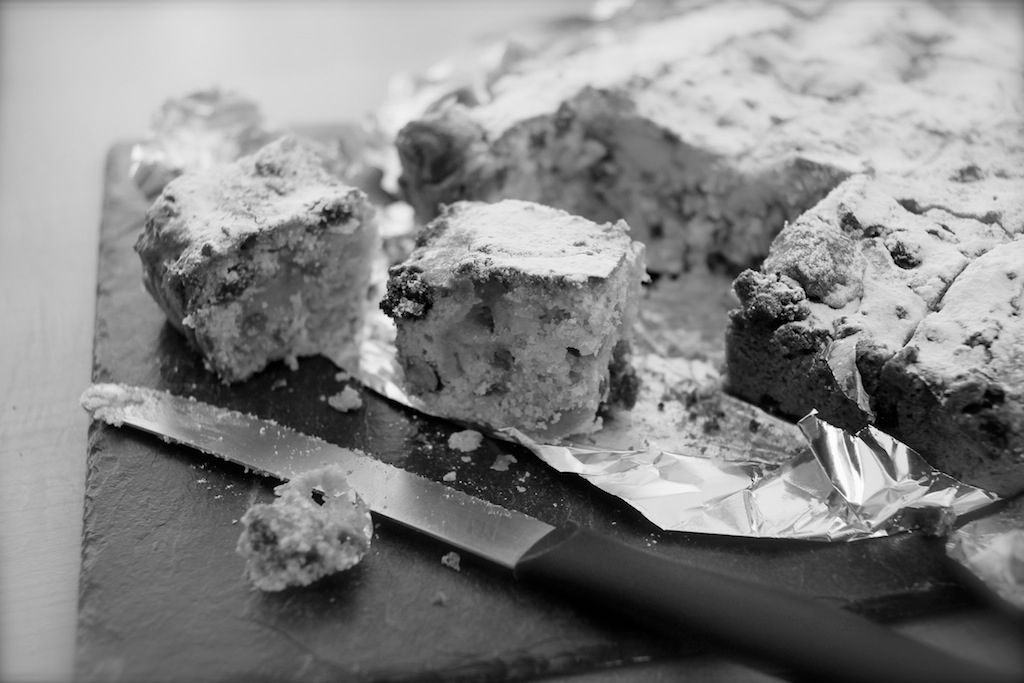
However, there's still a gap as far as stollen is concerned. Ever since I discovered this baked delight a few years ago - I can't actually remember when I had my first taste, but it had me hooked - I've tried every year to create the perfect stollen. For those of you who have never tried it, sort this out. It's a delicious cross between a bread and a cake, studded with dried fruit and nuts, with a thick vein of marzipan running through the middle. It's often glazed with butter and liberal amounts of icing sugar, and scented with spices like cardamom and cinnamon.
The first recipe I tried was from a book that came with our bread-making machine at home. I made the fruity dough in the breadmaker, stuffed it with marzipan and baked it. The result was rather like a giant, elongated hot cross bun. It was bready rather than cakey, with quite a loose crumb. It was delicious, especially toasted and buttered, but not really what I was after. Stollen should have quite a dense texture, closer to bread than cake. It's moist yet crumbly at the same time, often from the addition of ground almonds.
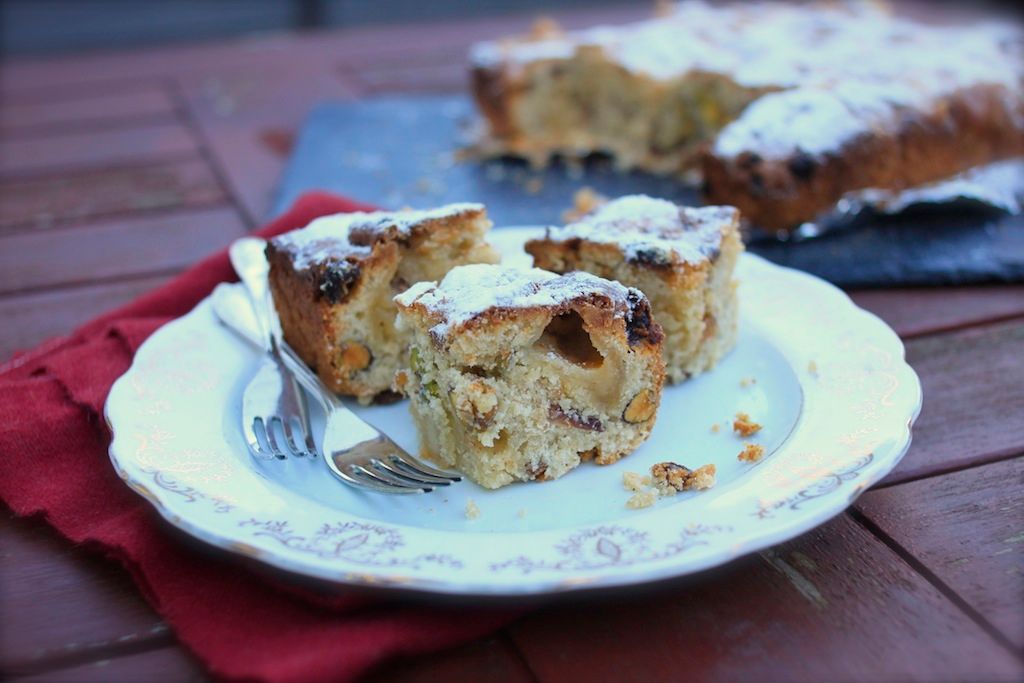
The next recipe I tried was Dan Lepard's sour cherry stollen. This was much closer to what I wanted: it had a lovely cakey texture and was even better after maturing, soaked in rum, sugar and butter, for a few days (although I obviously had to nibble a piece before I put it away for its little rum bath, just to quality control). It had a lovely cardamom flavour, which I think is essential to a good stollen - the combination of super-sugary marzipan and the citrus hit of cardamom is fabulous. It's like the gastronomic equivalent of getting a snowball in the face. But in a good way.
Last year, I tried Richard Bertinet's stollen recipe, which was in the delicious magazine Christmas issue. The main advantage of this recipe was that it made not one, not two, but four stollen loaves. It was quite involved - a lot of kneading and proving and folding fruit into dough, as well as making a 'creme d'amande' out of eggs, sugar, ground almonds and butter - but the end result was gorgeous. The crumb texture was very buttery, rather like a croissant, with a wonderful almond hit. We froze two of the stollen and my mum begged me on a monthly basis throughout the following year to allow her to defrost one and eat it.
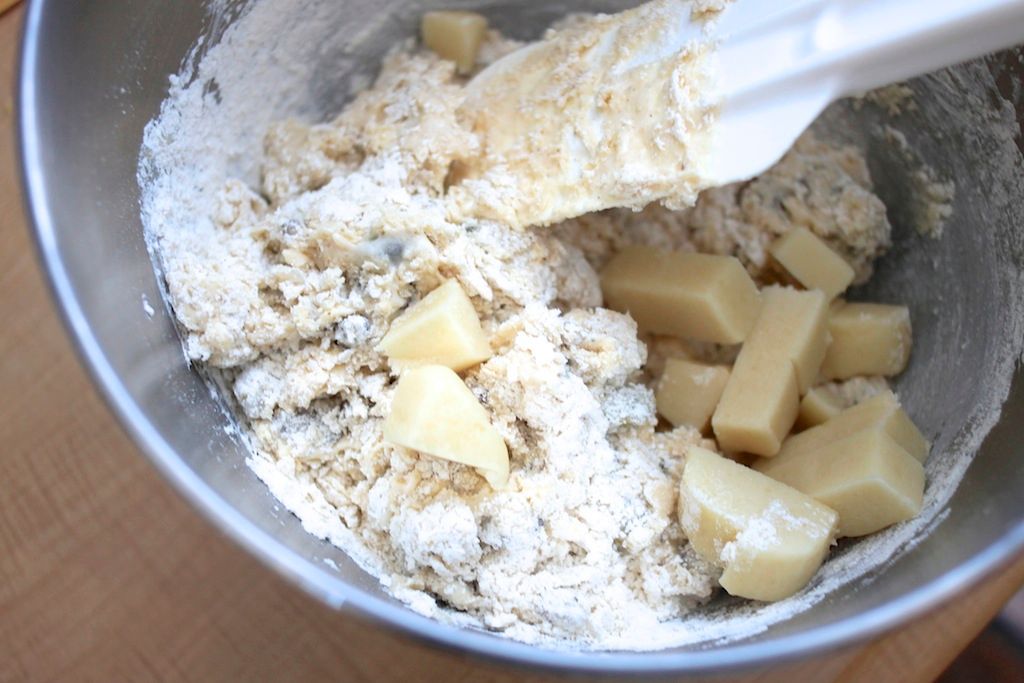
This year, I think I'll probably make the Bertinet version again. However, this recipe for orange and pistachio stollen bars, another Dan Lepard creation, has been sitting in my Bookmarks folder for an entire year, since it appeared in the 2011 Observer Christmas food special. The other day I felt the urge to bake something festive, and these sprung to mind.
The advantage of these is that they are incredibly quick and easy to make. Pretty much everything just goes into a bowl, then a pan, then the oven, then your mouth. No kneading or proving, as you often get with the more bread-like stollen recipes. Yet the end result tastes pretty much exactly like real stollen. There's that dense, cakey crumb - made with the addition of cream cheese, which I think gives it its richness - the hit of cardamom, juicy pieces of raisin, crunchy pistachios, and finally the delicious grainy squidgyness of marzipan pieces. The crumb is also infused with orange extract, which gives it a delicious Christmassy flavour.
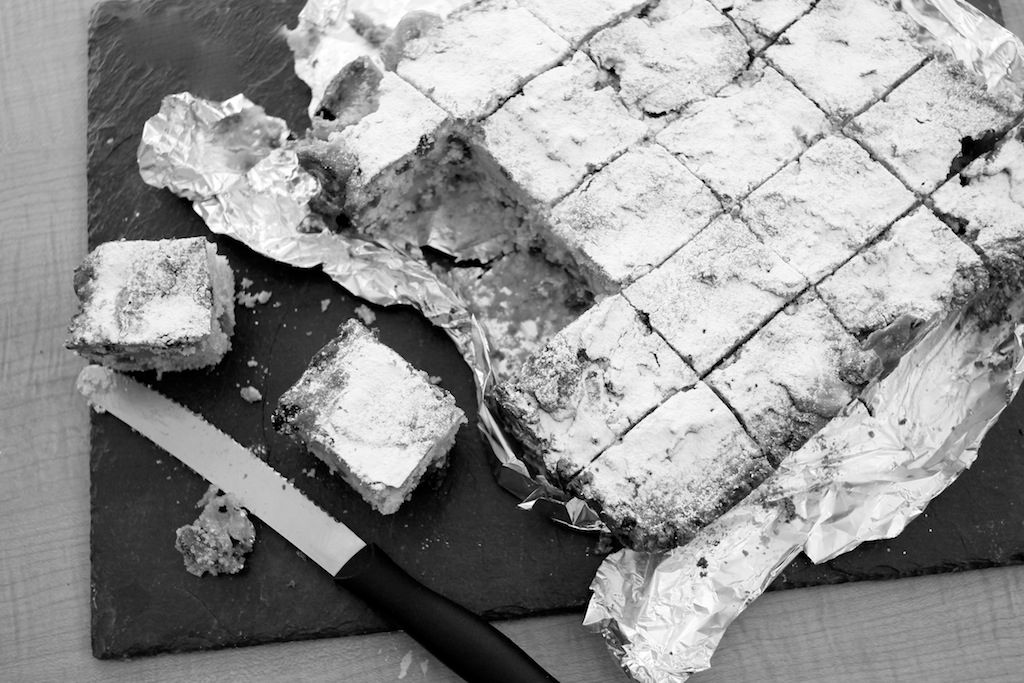
Also, because it's baked in a wide tray, you get more of the delicious crunchy, caramelised crust, which is one of the best bits of stollen. Particularly here where pieces of marzipan near the surface of the mixture bubble up in the oven and turn crunchy and toffee-like.
When I make these again, I think I'll chop the pistachios rather than leave them whole, as I prefer a little bit of crunch rather than whole nuts. I'd also chop the marzipan into smaller pieces - Dan suggests 2cm squares, but that's a sizeable chunk of marzipan to chew on, and they're also harder to fold through the batter, which is pretty dense already. [Since I wrote this post I have indeed made them again, and can confirm that chopping the nuts and using smaller marzipan pieces is definitely the way forward]. I think the raisins would be excellent replaced with dried cranberries or cherries, or maybe with some dried apricots added too.
The best part of this is removing the warm cake from the oven, then brushing it with melted butter and dousing it in icing sugar. The smell as it bakes is sumptuous, filling the kitchen with the aroma of Christmas; fruit, spice, nuts and butter. Slicing the cake into squares is also deeply satisfying, particularly when crumbs or corners end up crumbling off and you have to eat them to neaten everything up.
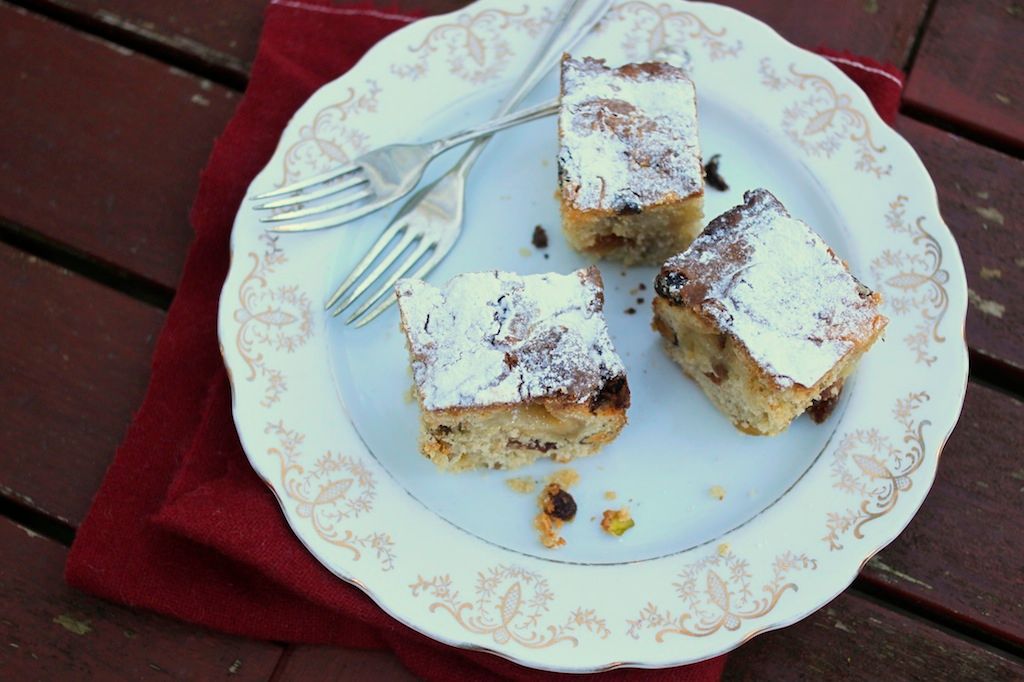
While not a true stollen, these may just make it onto my list of 'go-to' Christmas recipes. All the flavour of stollen, with none of the faff. Apparently they keep for a good while if you're generous with the melted butter and sugar, and wrap them tightly in foil. But of course, if you're generous with the melted butter and sugar, you're going to want to devour them all in an indecently short amount of time, as I did. Fortunately my department at university has an actual thing that we call 'Cake Thursday', which involves sharing home-baked treats on a weekly basis. Without these human bins in which to dispose of all my baking, I would be well on the way to obesity right now. It's cold up in York. I need baked goods for insulation.
These little squares are the essence of Christmas. Whip up a batch to sustain you through the arduous weeks of shopping, card-writing and turkey-buying ahead. Make some and give them to your friends. Just make sure they don't have a nut allergy.
For the recipe, from Dan Lepard, click here.
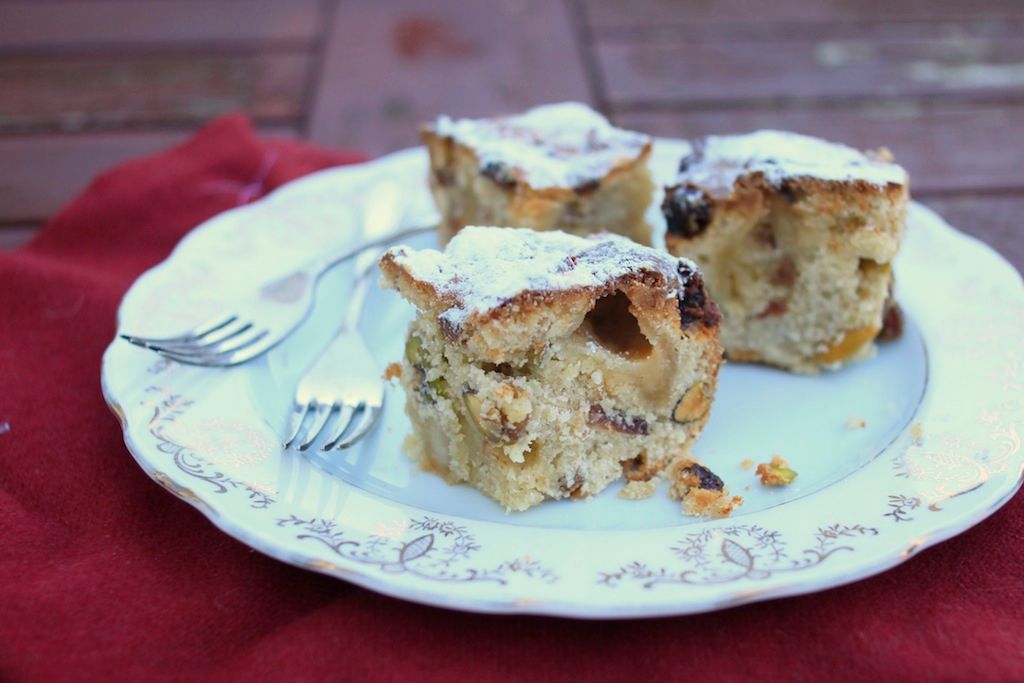
California prune, broad bean, feta and pecan salad
Prunes are an unfairly overlooked ingredient. Perhaps this is because of their rather menacing appearance: prunes are dark, wrinkled and gnarled in comparison to their plump, sunny cousins - dried apricots. Apricots just look much more user friendly, with their fat, honey coloured flesh. They crop up in many more recipes and seem to be the 'go-to' dried fruit for a lot of cooks, perhaps after raisins or sultanas. I think prunes carry a lot of unfair associations with school dinners, health food, and elderly people. It's sometimes easy to forget that they are, in fact, just dried plums - nothing remotely ominous about that.
Prunes have a huge amount to offer, both raw and cooked. They have a gorgeous rich stickiness to them that, in common with dates, I think makes them just as satisfying as a dessert. They have a real complexity of flavour, with notes of berry, wine, sometimes even chocolate. They are hugely versatile, working equally well in both sweet and savoury dishes - lending a sweet squidgyness to a chocolate brownie or tart, for example, or a bite of fruitiness to a rich lamb tagine.
Prunes are also pretty good for the health-conscious. They count as one of your five-a-day, are full of vitamins, and are low-GI so fill you up for a long time. They can also be used to great effect in healthy (but not boring) recipes - I make a delicious chocolate brownie that replaces the butter with prune puree, making it a lot more justifiable to eat several in one go. I've fed them to people who never guessed they weren't ordinary brownies (but mostly I've saved them all for myself). I imagine you could try a similar trick with general chocolate cakes, or other dark cakes.
I was recently sent some California Prunes to try, and couldn't refuse given my love of dried fruit. 60% of the world's plum production occurs in California, where the environmental conditions produce fruit that ripens fully on the tree, resulting in a perfect sugar content and full flavour. The prunes are delicious; sweet, rich and the perfect moist, sticky consistency - I'm not a fan of those over-dried ones that resemble leather and have to be rehydrated before eating. These also came individually wrapped, which I kind of loved. They looked like sweeties...only substantially better for you! (Should you want some for yourself, they sell them in Holland & Barrett and Tesco.)
I was fascinated by one of the recipe suggestions that accompanied my sample: a salad of prunes, broad beans, watercress, feta and pecans. Given my love of unusual salad combinations and anything involving fruit (particularly with meat and/or cheese), I had to try it. I've only ever used prunes in savoury recipes involving quite rich meat before, never something light and vegetable-heavy, so I was intrigued.
This is a surprising salad. I wasn't sure it would work, and in the end I was rather astounded by how tasty it was. There's a simple dressing of wholegrain mustard, honey and white wine vinegar - but I didn't have any of the latter so used lime juice, which was great. Watercress, mange tout and broad beans are tossed in the dressing (the recipe uses raw mange tout, but I boiled mine briefly to take the bitter edge off), then some chopped prunes, chopped pecans and crumbled feta. That is it.
The result is a fantastic combination of textures: grainy broad beans, crunchy mange tout and pecans, soft feta and delightfully squidgy prune pieces. There's just the right balance of saltiness (from the feta), acidity (from the mustard and lime juice/vinegar), sweetness (from the prunes) and bitterness (from the watercress and mange tout). It's a really pretty salad, very nutritious, and very filling too. I'm looking forward to trying out more salad recipes with prunes in the future, maybe with some leftover roast chicken or lamb, and some pine nuts...
The original recipe is here, on the California Prunes website, along with a vast number of other tempting suggestions (I'm particularly excited by the prune, amaretti and citrus tarts, and the prune, pecan and celery stuffed chicken). My slightly altered version is below; adjust quantities if you wish - you might want lots more pecans, if you're a big fan, or more feta, if you like salty food, et cetera.
If you're sceptical, I promise you this salad is really delicious. If you can't bear the idea of a vegetarian meal, I reckon it would make a great side dish to chicken or lamb.
Eat, enjoy, and give the poor prune a chance!
Prune, broad bean, feta, watercress and pecan salad (serves 1, easily multiplied):
- 100g frozen broad beans
- 40g mange tout, roughly chopped
- 1 tsp honey
- 1 tsp wholegrain mustard
- 1 tbsp lime juice (bottled or fresh) - or use lemon juice or white wine vinegar
- Salt and pepper
- Two big handfuls of spinach, watercress and rocket salad
- 15g pecan nuts, chopped (toast them first if you like for extra flavour)
- 50g feta cheese, crumbled
- 6 prunes, quartered
Bring a pan of water to the boil. Add the broad beans and cook for 5 minutes. One minute before the end, add the mange tout. When tender, drain well and set aside.
In a large bowl, mix together the honey, mustard and lime juice with some salt and pepper. Add the broad beans and mange tout and the salad, and toss together. Add the pecans, feta and prunes and toss together before piling onto a plate. Serve immediately.















